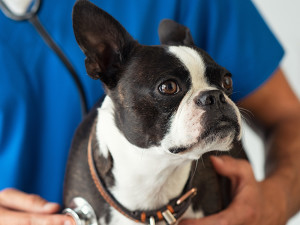The Most Expensive Dog Breeds to Insure (How to Reduce Your Pet Insurance Premium)
How to get that insurance premium down (without sacrificing your pup’s health)

Share Article
Being a pet parent comes with countless joys, but it also brings a fair share of responsibilities, including finding the right insurance for your dog. While choosing the right dog breed for you is often based on preference and lifestyle, it’s also essential to consider the potential costs involved in insuring your chosen breed. Your choice can significantly impact the premiums you’ll pay.
Don’t get us wrong, choosing the perfect dog breed to welcome into your family is an exciting time, but that doesn’t mean you shouldn’t exercise caution with your decision; many future pet parents fail to consider the long-term financial implications of breed on insurance, which can result in pups being given up to charities and sheltersopens in new tab. “In 2023, we received reports of more than 16,000 abandoned dogs and saw a three-year high in incidents of animals being abandoned – a problem that is being fuelled, we fear, by the cost of living crisis,” an RSPCA spokesperson told us.
Factors such as genetic conditions, health issues and even the breed’s popularity play significant roles in determining insurance premiums. We speak to an expert to shed light on why certain dog breeds are more expensive to insure and discuss valuable tips on how to potentially reduce insurance premiums through lifestyle adjustments and preventive measures.
Why is pet insurance so expensive?
You may have thought homework was a thing of the past, however when you start navigating your way through insurance policies, exclusions and premiums you may want to plug your brain back in. Zoe Blakeopens in new tab, a veterinary nurse and pet behaviour expert, explains the factors that contribute to the high insurance premiums for certain dog breeds. She emphasises, “Which breed you choose may be highly significant when you start to do your research (and make sure you do).” So why do certain breeds mean higher insurance premiums?
“Many breeds are known for acquiring genetic conditions or health issues,” she says. “Larger breeds will naturally bring about higher veterinary and medication costs. Companies will set about having breed-specific restrictions and exclusions so read the small print and ensure you fully understand the terms and conditions.”
Breed factors that may influence the cost of insurance premiums include:
Size
Insurance premiums for larger dogs tend to be more expensive for a number of reasons including third-party liability, veterinary costs and genetic conditions. Not all larger dogs are more aggressive of course, however, the bigger the dog, the more damage they’re able to cause to people, items or other dogs even by accident (because they got too excited, for example). If a larger pup needs medical attention, they will need more drugs (and surgery can be a bigger task) for example, plus, their size means breeds such as Great Danes are at a higher risk of inherited problems with their hips and back.
Genetics
As you start to research your chosen breed ensure you look at the facts and figures that will guide you through what may be a ‘typical’ health issue for them, says Zoe. Labradors, German Shepherds, Spaniels and Cockapoos are breeds that commonly suffer from joint-related issues, for example. Whereas brachycephalic (flat-faced) dog breeds (such as French Bulldogs and Pugs) are at a dangerously high risk of common health issues caused by generations of selective breeding. These include serious breathing issues (their nasal passages are shorter) and significant eye problems (due to shallow sockets).
Temperament
“Breeds that are known for having aggressive tendencies will pose a higher risk for liability claims,” says Zoe. Dogs that are on a list of banned breeds according to the Dangerous Dogs Act will be very costly to insure (plus, those pet parents will also need third-party public liability insuranceopens in new tab for their pup).
Popularity
The more insurance policies taken out for a particular breed can also impact the individual cost of insurance premiums. “A breed that’s in high demand could increase your premium as the claim pool will be naturally bigger as popularity comes at a cost,” says Zoe.
Location
Where you live (for example, rural vs urban areas) can have an impact on insurance premiums too, due to risk factors and vet prices. According to data from the insurance comparison site GoCompareopens in new tab, the capital comes in most expensive for pet insurance costs, with £80 separating the cheapest and most expensive averages (£419 in London vs £339 in the North East). “Living in certain areas may mean higher charges if historical data shows that more claims are made,” adds Zoe.
What are the most expensive dog breeds to insure?
According to research by GoCompare, certain breeds are consistently more expensive to insure. These breeds include the French Bulldog, English Bulldog and Dogue de Bordeaux. These breeds often come with a higher risk of health problems, thus increasing insurance premiums.
According to the GoCompare pet insurance index, these are the most expensive dog breeds to insure in 2024:
Cane Corso – average annual insurance premium of £873.62.
Dogue De Bordeaux – average annual insurance premium of £817.64.
Newfoundland – average annual insurance premium of £762.30.
Bernese Mountain Dog – average annual insurance premium of £724.29.
Chow Chow – average annual insurance premium of £712.38.
On the other end of scale, the cheapest dog breeds to insure in the UK are:
Cockapoo – average annual insurance premium of £228.81.
Jack Russell – average annual insurance premium of £254.14.
Patterdale Terrier – average annual insurance premium of £255.71.
Toy Poodle – average annual insurance premium of £266.51.
Chihuahua (long coat) – average annual insurance premium of £268.87.
What can you do to reduce your pet insurance premium?
Research is key before committing yourself to taking on any pet, says Zoe. Chat with friends and family who may already have the breed you are considering. When contacting breeders make sure you have asked the right questions to ensure genetic tests have been performed, for example, elbow/hip/eye scoring.
Once you have your pup home, not only is looking after their health and wellbeing top priority (as you would expect), but it can also reduce the cost of your insurance premiums and excess in the long run.
Keeping your pup healthy generally means “investing in a good quality diet that will ensure they maintain their body condition and try to avoid obesity at all costs,” says Zoe. “Like with us humans, obesity will predispose them to many health issues such as diabetes, heart disease, cancer and joint disease.”
“Dental disease is a common area that insurance companies will be strict about, so ensure your home dental hygiene is effective,” she adds. “Regularly look over and groom your dog to try and pick up on things early. Dogs like to see the world, exercise and getting outside into nature will improve both theirs and our mental wellbeing.”
Here are some additional factors that will keep your pup in tip-top conditions and could reduce your insurance costs in the long run:
Regular veterinary check-ups
You are your dog’s voice and advocate, and booking in regular check ups with their vet is a way of making sure that you’re checking over the things that they might not be able to tell us. “Disease progression can sometimes be slowed if we can make adjustments and medicate earlier, explains Zoe. Adding that knowing the ideal weight for your dog is important for monitoring at home, as well as understanding their body condition score.
“Remember that dogs age much quicker than us, especially as they reach their golden years,” adds Zoe. “Six months for us can equate to 3–4 years for them so regular check ups are vital to enable us to detect and treat conditions early.”
Dietary considerations
Much like their personalities, a dog’s diet will be completely individual based on a number of factors. “Diet is another complex subject that needs careful consideration when we are trying to provide for our dogs, explains Zoe. “It is very easy to get swept away with a bias opinion that has no scientific backing, so always ensure you are gaining information from a reputable source.”
The main influential factors should always be don’t overfeed, over treat nor over exercise as they can all lead to health problems, adds Zoe.
Exercise routines
Much like Goldilocks’ approach to her porridge, the amount of exercise for your dog should be juuuust right; not too much, not too little. You might be initially worried about what happens when you can’t walk your dog, but equally “exercising your puppy too much through their adolescent phase can lead to joint problems, so be mindful of this,” says Zoe. “Little and often is a great foundation to start, as each time they are exposed to the outside world their brains will be ignited with observing and learning.”
Breed-specific behaviours
Zoe advises, “When we research our breeds, it’s advisable to get an idea of their temperaments and their trainability.” Working breeds will need activities such as herding, while gundog types will need undergrowth and stimulation, for example. “Confining a dog with no physical or mental stimulation can be detrimental to their physical and emotional well-being,” she adds. “As much as we want to wrap our furry bundles up in cotton wool and protect them from injury, we need to allow them to explore and enjoy their lives, too.”
Insurance premiums can vary widely depending on so many factors, so it is essential that you research and compare options to ensure you understand the policy and its terms and conditions. Don’t be caught out when it is too late.
References:

Orla Pentelow
Orla Pentelow is Kinship UK’s Senior Editor. She has previously written for British Vogue, Bustle, Yahoo and The Telegraph. When not at her desk liking dog videos she’s out and about with her rescue pup, Luna, who works primarily as chief distractor.
Related articles
![A woman with dark curly hair lifting a box with a plant in a pot balanced on top to another area in the home]()
How to Prepare For an Adoption Home Visit
7 tips for acing your inspection and bringing your new pup home
![woman hugging dog]()
Where to Get Help If You’re Struggling to Afford Your Pet
If you’re struggling with pet care costs, you are far from alone and there’s no shame seeking help. Here’s a few places to start
![A woman staring at her computer while holding her dog close.]()
10 Things to Consider Before Adopting a Pet
It’s a big decision, so tick these boxes before you sign on the dotted line
What Are The Different Types Of Pet Insurance?
Everything you need to know about how pet insurance works in the UK
![cat in red bow tie being held up by hand]()
8 Things You Needn’t Splurge On For Your Pet (If You Don’t Want To)
If you don’t buy these things for your beloved cat or dog, you’re not a bad pet parent












